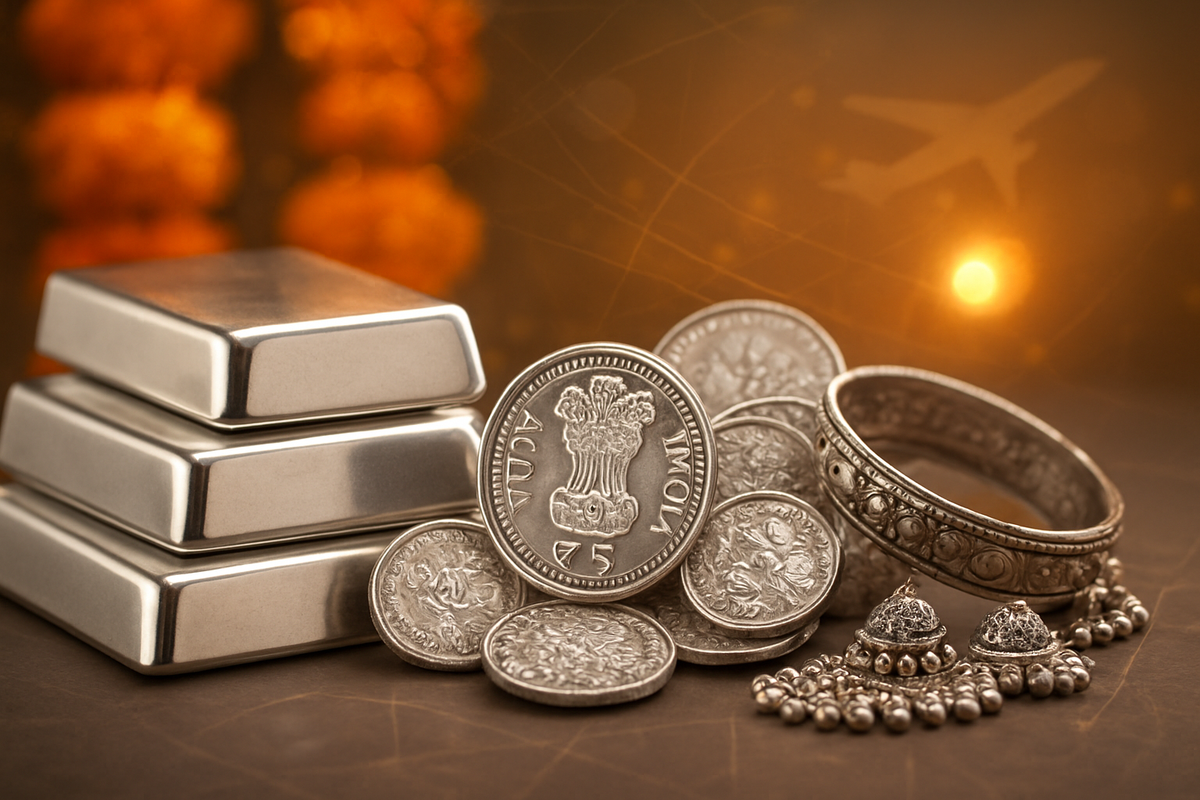
India is currently experiencing an unprecedented surge in silver demand, a phenomenon primarily fueled by a potent combination of traditional festival buying and robust global market dynamics. This intense demand has propelled silver prices to historic highs, with the metal significantly outperforming other assets, including gold, throughout 2025. The immediate implications are far-reaching, impacting not only the precious metals market and the broader Indian economy but also, surprisingly, casting a spotlight on the nation's burgeoning travel and tourism industry.
The confluence of strong domestic consumption, particularly during the recent Diwali and Dhanteras festivals, and a tightening global supply due to industrial demand and geopolitical tensions, has created a perfect storm for silver prices. This surge has led to significant price volatility, elevated premiums over international benchmarks, and widespread stockouts at major refineries. While presenting lucrative opportunities for investors, it simultaneously poses considerable challenges for consumers, industrial users, and has contributed to a widening trade deficit for India, underscoring the complex interplay of cultural, economic, and global factors at play.
Unpacking India's Silver Mania: A Deep Dive into the Current Surge
The Indian silver market has been a spectacle of remarkable growth throughout 2025, culminating in an extraordinary surge that sees prices hovering around ₹161 per gram (₹1,61,000 per kilogram) as of November 21, 2025. This represents an astonishing approximate 75% increase in domestic silver prices over the past year, cementing its status as one of India's top-performing assets and notably eclipsing gold's roughly 60% rise in the same period. The rally has been so intense that major precious metals refineries, such as MMTC-Pamp India Pvt., reported running out of silver stock for the first time, a testament to the insatiable demand.
The timeline leading to this moment has been characterized by several key events. The festive season, particularly Diwali in October 2025 and Dhanteras (October 31, 2025), acted as a powerful catalyst. Millions of Indian consumers, driven by cultural traditions and viewing silver as a more accessible alternative to increasingly expensive gold, flocked to purchase the metal. This festive buying spree was so intense that even a temporary dip in silver rates on Dhanteras triggered a fresh wave of purchasing, leading to bidding wars among dealers in Mumbai and significant premiums over international prices. Simultaneously, global factors have been at play throughout the year, with a persistent supply deficit, strong industrial demand from the green energy transition, and geopolitical uncertainties steadily pushing international prices upwards, which then translated into higher domestic prices exacerbated by a weakening Indian Rupee.
Key players and stakeholders involved in this silver surge include the millions of Indian households engaging in festive buying, domestic jewelers and retailers grappling with unprecedented demand and supply shortages, and global investors and hedge funds channeling significant capital into silver. On the supply side, international miners and refineries are struggling to meet the escalating demand, while Indian importers are navigating high import duties, GST, and logistical bottlenecks. The initial market reaction has been one of both exhilaration and caution. While Silver Exchange Traded Funds (ETFs) in India have delivered exceptional year-to-date returns, surging by approximately 69%, some fund houses like ICICI Prudential Mutual Fund and Kotak Mutual Fund have even temporarily halted fresh lump sum investments in their silver ETF fund of funds, citing concerns over potentially overinflated prices and aiming to protect investors.
Beyond the precious metals sector, the surge has presented an unexpected impact on the travel and tourism industry. While seemingly unrelated, the significant diversion of household savings and disposable income towards silver purchases during the festive season has subtly, yet noticeably, altered consumer spending patterns. Initial reactions from the travel sector indicate a slight, albeit temporary, dampening of discretionary spending on travel experiences, particularly for domestic tourism, as families prioritize traditional silver acquisitions over leisure activities during this peak festive period. This unexpected correlation highlights the deep cultural and economic ties that bind precious metal consumption to broader consumer behavior in India.
Corporate Fortunes: Winners and Losers in the Silver Rush and Travel Sector
The current silver surge in India is creating a distinct divide between potential winners and losers across various industries, particularly within the precious metals and, surprisingly, the travel and tourism sectors.
In the precious metals space, silver mining companies globally stand to gain significantly from sustained high prices. While India itself has limited primary silver mining, international giants like Fresnillo PLC (LSE: FRES) and Pan American Silver Corp. (NASDAQ: PAAS) are poised to benefit from increased revenues and profitability, assuming their production costs remain stable. Domestically, precious metal refineries and importers that managed to secure supply before or during the initial stages of the surge, such as MMTC-Pamp India Pvt. (a joint venture between MMTC Ltd. and MKS PAMP), have seen immense demand, though they face challenges in maintaining stock. Companies involved in silver ETFs in India, such as those managed by ICICI Prudential Mutual Fund and Kotak Mutual Fund, have witnessed substantial asset under management (AUM) growth and delivered impressive returns to existing investors, although the temporary halt on new lump sum investments indicates a cautious approach to prevent overvaluation.
Conversely, the immediate impact on jewelry retailers in India, while initially positive due to high festive sales, presents a mixed bag. Companies like Titan Company Limited (NSE: TITAN), a major player in the Indian jewelry market through its Tanishq brand, benefit from robust demand but also face the challenge of managing higher input costs and potential inventory shortages. The soaring silver prices mean higher working capital requirements and the risk of reduced profit margins if they cannot pass on the full cost increase to price-sensitive consumers. Similarly, industrial users of silver in India, particularly those in electronics, solar panel manufacturing, and electric vehicle components, face increased production costs. This could impact the profitability of companies like Tata Motors (NSE: TATAMOTORS) or Mahindra & Mahindra (NSE: M&M) if the cost of silver, a critical component in their EV and electronics segments, continues its upward trajectory.
The unexpected losers from the silver surge are primarily within the travel and tourism industry. As Indian households divert a significant portion of their discretionary spending towards purchasing silver during the festive season, less capital is available for leisure travel. This could temporarily affect revenues for major airlines like IndiGo (InterGlobe Aviation Ltd.) (NSE: INDIGO) and SpiceJet Ltd. (NSE: SPICEJET), as well as hospitality chains such as Indian Hotels Company Limited (NSE: INDHOTEL), which operates the Taj Group, and EIH Limited (NSE: EIH), which owns Oberoi Hotels. Tour operators and online travel agencies like MakeMyTrip Limited (NASDAQ: MMYT) might also experience a short-term dip in bookings, particularly for domestic leisure packages, as consumers prioritize tangible assets over experiences during this period of high silver prices. While this impact might be temporary and localized to the festive season, it underscores the sensitivity of consumer spending to shifts in traditional investment patterns.
Wider Significance: A Confluence of Trends and Unforeseen Repercussions
The current silver surge in India is more than just a localized price rally; it's a powerful illustration of several converging global and domestic trends, with significant ripple effects across various sectors and potential policy implications. This event fits squarely into the broader industry trend of increasing demand for "green metals" driven by the global energy transition. Silver's critical role in solar panels, electric vehicles, and 5G infrastructure means that its demand is structurally growing, regardless of traditional investment or jewelry consumption. The fact that approximately 70-75% of global silver output is a by-product of mining other metals makes its supply relatively inelastic, exacerbating price sensitivity when demand spikes.
The ripple effects extend far beyond the direct participants. Competitors in the precious metals market, particularly gold, are seeing silver steal some of its thunder as an investment asset, especially for those seeking a more affordable entry point or higher short-term returns. For industrial partners, especially those in the rapidly expanding renewable energy sector, the rising cost of silver translates directly into higher production costs, potentially impacting the profitability and deployment speed of green technologies. This could lead to innovation in silver-saving technologies or a search for alternative materials, though silver's unique properties make it difficult to substitute in many applications.
From a regulatory and policy perspective, the surge highlights several critical areas. The significant premium of Indian silver prices over international benchmarks, partly due to high import duties and GST, raises questions about the government's role in balancing revenue generation with consumer affordability and industry competitiveness. The widening merchandise trade deficit in October 2025, partly attributed to increased silver imports, will undoubtedly draw attention from policymakers concerned about India's foreign exchange reserves and overall economic stability. There might be renewed discussions around import duty structures or measures to curb non-essential imports, though silver's dual role as both a cultural asset and an industrial metal complicates such decisions.
Historically, India has always been a significant consumer of precious metals, particularly during festivals and weddings. However, the current surge, driven by a global supply deficit and robust industrial demand alongside traditional buying, sets it apart from previous rallies primarily fueled by inflation or safe-haven demand alone. Comparisons can be drawn to past periods of high commodity prices, where supply-demand imbalances led to significant market dislocations. The unexpected impact on the travel and tourism industry, however, is a newer phenomenon, reflecting how deeply intertwined India's cultural practices and economic decisions are, where discretionary spending can quickly shift based on perceived value and traditional priorities.
The Road Ahead: Navigating the Silver Landscape and Its Broader Implications
Looking ahead, the silver market in India and its wider implications present a complex and dynamic landscape. In the short term, the post-festive season might see a temporary cooling of domestic retail demand, potentially easing some of the immediate price pressure and premiums. However, the structural factors driving the global silver market – the persistent supply deficit, robust industrial demand from the green energy transition, and ongoing geopolitical uncertainties – are expected to maintain a bullish undertone for prices. Investors should anticipate continued volatility, with prices likely to fluctuate in response to global economic data, interest rate expectations, and shifts in industrial procurement.
For the travel and tourism industry, the short-term impact of diverted festive spending on silver is likely to subside as the immediate buying frenzy passes. However, the event serves as a crucial reminder for travel companies to understand and adapt to the unique cultural and economic rhythms of the Indian market. Strategic pivots might involve offering more flexible booking options, targeted promotions during non-festive periods, or emphasizing value-added experiences to attract consumers. The market opportunities for travel could re-emerge strongly in the coming months, especially if the perceived value of silver stabilizes, allowing discretionary spending to flow back into leisure activities.
In the long term, the trajectory of silver prices will largely depend on the pace of the global green energy transition and the ability of mining operations to increase supply. If the transition accelerates as projected, silver demand from solar, EV, and electronics sectors will likely continue to outstrip supply, keeping prices elevated. This could lead to increased exploration and investment in new silver mines, though these projects have long lead times. For India, the challenge will be to manage the economic implications of high silver imports, potentially exploring domestic recycling initiatives or encouraging more efficient use of the metal in industrial applications.
Potential scenarios and outcomes include a continued upward trend in silver prices, albeit with periodic corrections, driven by sustained industrial demand and investment interest. Alternatively, a significant global economic downturn or a breakthrough in silver-saving technologies could temper demand. For the travel sector, a resilient rebound is probable, but companies that innovate in marketing and service delivery to align with evolving consumer priorities will be best positioned. The broader significance lies in recognizing how interconnected global commodity markets are with local cultural practices and consumer behavior, leading to unexpected ripple effects that require nuanced strategic responses from both businesses and policymakers.
A Gleaming Future? Assessing the Lasting Impact of India's Silver Surge
The current silver surge in India is a multifaceted event, serving as a powerful testament to the enduring cultural significance of precious metals in the country, coupled with the formidable forces of global industrial demand and economic uncertainties. The key takeaway is the extraordinary confluence of domestic festive buying, which saw unprecedented consumer interest and even stockouts, and international factors like a persistent supply deficit and the burgeoning green energy transition that relies heavily on silver. This combination has propelled silver prices to remarkable highs, making it a standout performer in the financial markets of 2025.
Moving forward, the market for silver appears poised for continued strength, albeit with an inherent degree of volatility. The structural imbalance between supply and demand, particularly from the industrial sector, suggests that silver's long-term trajectory remains bullish. However, investors and consumers alike should remain vigilant about short-term price fluctuations, which can be influenced by global economic sentiment, currency movements, and shifts in investor appetite. The significant premiums for physical silver in India also highlight the ongoing challenges of logistics, import duties, and domestic supply constraints.
The lasting impact of this surge extends beyond mere price appreciation. It has underscored silver's dual identity as both a traditional store of wealth and a critical industrial commodity. For the Indian economy, it has brought both opportunities for investors and challenges in managing trade deficits and inflationary pressures. The unexpected, albeit temporary, ripple effect on the travel and tourism industry serves as a unique case study, illustrating how deeply cultural spending patterns can influence seemingly unrelated sectors. It emphasizes the need for businesses in diverse industries to understand the intricate web of consumer behavior in a culturally rich market like India.
Investors should watch for several key indicators in the coming months. These include global industrial production data, particularly in the solar and EV sectors, which will dictate long-term demand. Monitoring global silver mine supply and recycling rates will be crucial for assessing the supply side. Domestically, tracking Indian import figures for silver, changes in government policy regarding import duties or GST, and consumer spending trends post-festive season will provide insights into the market's direction. For the travel sector, observing booking trends and discretionary spending habits after the festive rush will be vital. The silver surge of 2025 is not just a financial headline; it's a profound economic and cultural narrative unfolding in real-time.
This content is intended for informational purposes only and is not financial advice





